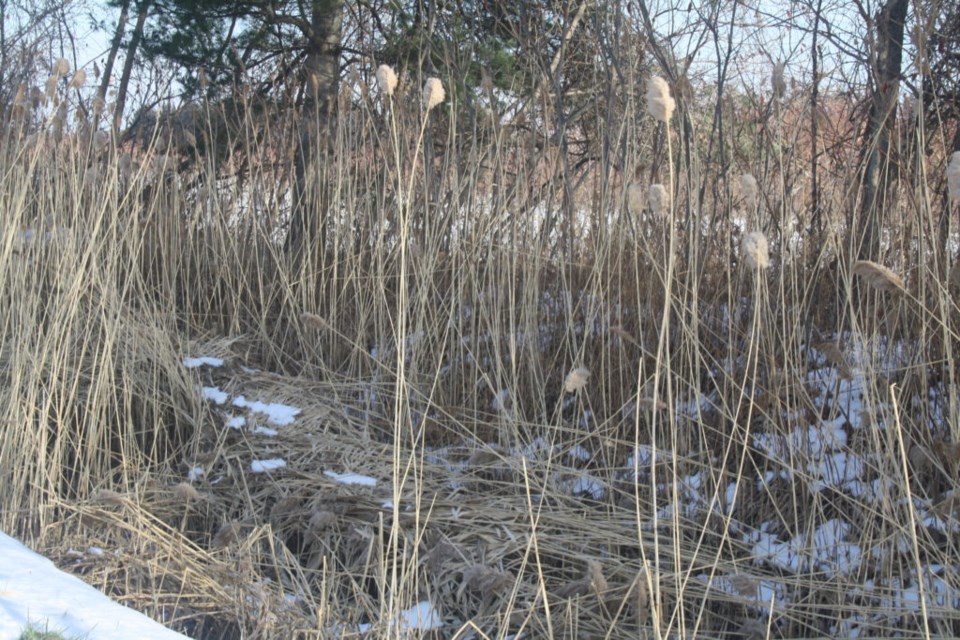
While the Town is taking some steps this year toward stamping out phragmites, it could be a decade before the invasive plant is eradicated.
One of the expensive items in the 2020 operating budget is a new full-time employee, and equipment to fight the escalating battle with the invasive plant, but that plan isn’t likely to be activated until next year, says environmental supervisor Brett Ruck.
Despite efforts to control it, phragmites continue to spread, choking municipal drains and ditches, and blocking the flow of water in irrigation channels, which has become a serious issue for farmers.
When they need water, they have a window of about a day to a day-and-a-half, and in the past, it has taken about a week to get a contractor to clean the ditches and get the water flowing, says Ruck — and that’s too long for a farmer to wait.
Attempts to remove the vegetation have been slow and challenging, with the methods they’ve been using contributing to the spread of seeds — each pod contains about 20,000 seeds, which are easily spread. “That’s a lot of regermination,” says Ruck.
He hopes to have a plan for council approval to purchase the equipment he is suggesting is needed to eradicate phragmites, but once that occurs, it would still be about six months after the order is placed before it’s delivered, meaning it will be 2021 before they even begin working with it. There is a phragmites meeting in early March to finalize a document for council, which he hopes will result in approval to purchase the equipment, which while expensive, would be more efficient and less costly over the long term than contracting the work, says Ruck. And if the Town owns the equipment, it can be used in other departments.
“In my opinion, the best option is to purchase the equipment. If we have to contract, we’ll spend as much or more, and we can’t be as responsive. If we own the equipment, we can move it as needed,” says Ruck. “Hopefully, everyone will be on the same page.”
And at the end of the day, “this will lower the cost around 20 per cent.”
Otherwise, when water is needed for irrigation, “we can’t always get it to the farmer in a reasonable amount of time.”
He has a contingency plan to get through the coming season, he says. He’s found a couple of contractors who say they can respond within 24 hours.
Once phragmites are cleared from ditches and drains, he says, it would be beneficial to use chemical spray to further ensure it won’t return. He has also been in touch with the Ministry of Agriculture and the Ministry of the Environment to talk about spraying — he can get rid of the plant much faster if that can be done with no harm to nearby crops.
The cost of purchasing the equipment, which includes a basket that scrapes the stocks and contains them and the pods, reducing the spread of seeds, would be just over $400,000. The salary and benefits of a contract staff person to operate it is about $82,000 a year, although he may use an internal staff member in the off-season. About 60 per cent of the cost will be funded by the rates charged to those who use the ditches for irrigation, and the property owners who share the cost of drain maintenance, says Ruck. The remainder will come from the operating levy, out of the roads and storm water budgets.
While the focus of the work going forward is on eradicating phragmites from municipal drains and ditches, a Town irrigation committee is also intending to look at how to help residents rid their private property of the weed.
“We haven’t gone down that road yet, but when we have the equipment, we can work out something for private property,” says Ruck.
“I feel confident I can get ahead of it, but I need to get started, and to find the combination of management tools that work best. Cutting is fastest, but I feel eventually we’ll have to do some spraying. With a good management plan, I think we can get rid of it, but it will take a minimum of five years to get it under control, and another two to five years after that to eradicate it. If we could spray, it could be quicker, but without that, it will take a long time.”
The Town has an area near the Lakeshore Road cemetery to dump the seeds and stocks — not ideal, but the best they’ve got at the moment, says Ruck. The plan is to let the material dry out and then burn it.
In the meantime, while future plans are being considered, “important progress has been made in the education of farmers and land owners, who now understand what phragmites looks like, what it does and how bad it is.”